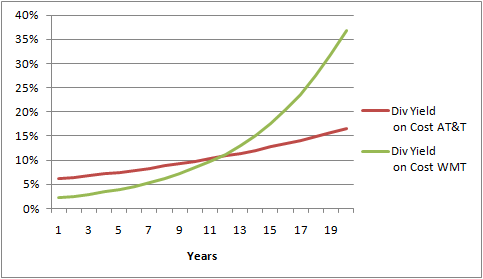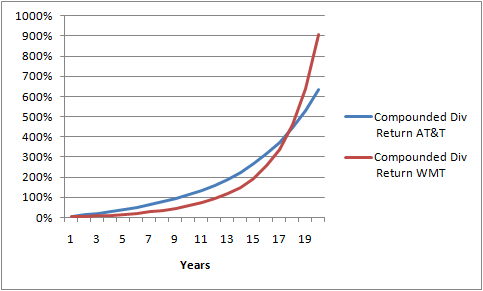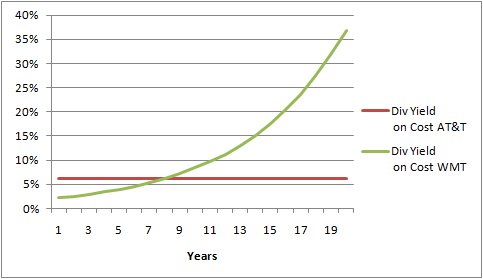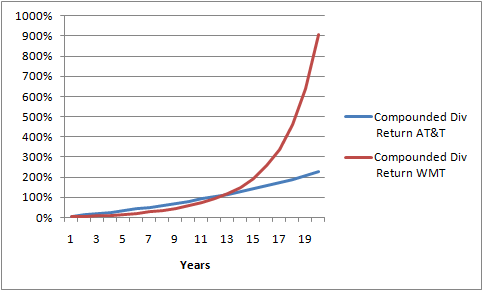When looking to build a long-term portfolio of stocks that pay high dividends, investors usually come up with a mix of stocks that either have high dividend yields or high dividend growth rates. It is difficult to find good companies that have both. This means that there is often a choice to be made. All else equal, should one invest in the company that has that enticing high dividend yield, but a low dividend growth rate, or does one exude patience and invest in the company with a relatively low yield, but a high dividend growth rate? To help answer this question I looked at two companies that offer these different alternatives: AT&T (T)and Walmart (WMT).
AT&T:
Div Yield | 1 Year Div Growth Rate | 5 Year Div Growth Rate | Payout Ratio |
6.10% | 2.40% | 5.40% | 50.00% |
Walmart:
Div Yield | 1 Year Div Growth Rate | 5 Year Div Growth Rate | Payout Ratio |
2.20% | 14.70% | 16.00% | 29.00% |
The differences in the dividend yields as well as the growth rates are striking. This presents a great case study in which company will give the investor a greater return due to dividends over time. More specifically, I want to measure the yield on cost and how it changes over time as well as the compounded annual return due to dividends. The yield on cost simply measures the annual dividend divdided by the original investment in the company’s stock.
Starting with the simplified assumption that the growth rate of each dividend follows the five year growth rate, we see the following:


Somewhat surprisingly, it takes nearly 12 years for the yield on cost for Walmart to break even with the yield on cost for AT&T. Of course, due to compounding we see the yield on cost for Walmart explode upward eventually. But this assumes that Walmart can continue its high rate of dividend growth after 12 years. Even if we assume that Walmart’s dividend growth rate continues at this high rate after 12 years, it still takes nearly 18 years for the compounded total return due to dividends to break even with AT&T, assuming dividends are always reinvested.


Let’s also look at a more dire scenario for AT&T where their dividend does not grow at all and Walmart continues at the five year growth rate of 16%.
The yields on cost break even in about eight years in this scenario and the time it takes for the compounded return due to dividends to equalize is slightly less than 13 years.




When constructing a dividend portfolio for the long-run, it is important to keep in mind just how long it might take for a lower dividend yield to catch up with a stock that pays a higher yield. That low yield stock that you think will have stellar dividend growth rates might still not be worth putting in your portfolio until the dividend yield has risen enough to make it worthwhile. Readers can input their own assumptions for any stocks and see the break-even yields on cost as well as compounded rates of return due to dividends in this spreadsheet- Dividend Break-Even Evaluator.
Disclosure: I am long T.
Wikio
No comments:
Post a Comment